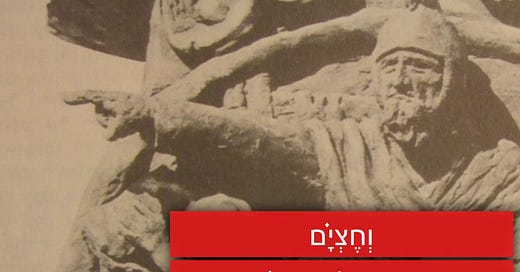There is an image from today’s chapter that feels hauntingly familiar from every heroic narrative of pioneers on the plains or some hilltop, building new homes on lands that are new to them - but not new to those who’ve been there before.
The reality on the ground in Judah 2,500 years ago informed the story told again so many generations later.
There are growing tensions between the locals around Jerusalem who are suspicious of Nehemiah’s wall building project -- and the Judeans inside the city who fear for their lives.
Under Nehemiah’s leadership they assemble whatever weapons they have, and even without an official militia or army they arm themselves while working on the wall:
הַבּוֹנִ֧ים בַּחוֹמָ֛ה וְהַנֹּשְׂאִ֥ים בַּסֶּ֖בֶל עֹמְשִׂ֑ים בְּאַחַ֤ת יָדוֹ֙ עֹשֶׂ֣ה בַמְּלָאכָ֔ה וְאַחַ֖ת מַחֲזֶ֥קֶת הַשָּֽׁלַח׃ וַאֲנַ֖חְנוּ עֹשִׂ֣ים בַּמְּלָאכָ֑ה וְחֶצְיָ֗ם מַחֲזִיקִים֙ בָּֽרְמָחִ֔ים מֵעֲל֣וֹת הַשַּׁ֔חַר עַ֖ד צֵ֥את הַכּוֹכָבִֽים׃
The builders or the wall and those who carried the baskets were burdened, doing work with one hand while in the other holding a weapon.
And so we worked on, while half were holding lances, from the break of day until the stars appeared.
Nehemiah 4:11-15
One hand with tool, the second with weapons - working around the clock - is how this text describes what it took to build up safety - but at what price?
Rabbi Dalia Marx comments on this detail in Nehemiah’s narrative with an eye to its modern echoes in the modern return to Jerusalem:
“The Knesset Menorah – One of the New Symbols of Jerusalem - was gifted to the young State of Israel by the British government in 1956, and it stands in the Rose Garden. The branches of the menorah, designed by the artist Benno Elkan, bear thirty reliefs that depict events from the history of the Jewish people, and as such, some refer to it as a "textbook in bronze."
The events are arranged in pairs, positioned opposite one another. Opposite a relief of exiles weeping by the rivers of Babylon, with their harps lying at their feet, stands a relief depicting the Return to Zion. Nehemiah holds in his hand the scroll of Artaxerxes, granting permission for the rebuilding of Jerusalem, pointing toward Zion and overseeing the work of the builders.
This relief is unique among all those on the menorah because it includes a detail that goes beyond the historical period it depicts: a modern pioneer appears in the scene, standing guard with a weapon in his arms. Through this “importation” of the Zionist pioneer into the ancient scene, the artist forged a connection between the Return to Zion during the Second Temple period and the modern Return to Zion—in both, the task of construction and the task of defense were inseparable.
In time, this formula became the model for the modern-day returnees to Zion: the tasks of building and creativity were inseparable from the need for vigilance and defense.
And may the day not be far off when we can build and create with peace of mind and in tranquility!”
Rabbi Dalia’s closing words, written before this current war, feel painfully aspirational.
Weapons are now everywhere in Israel, worn by soldiers in uniform and those on leave, and by many civilians. The image of pioneers building the homeland with weapons in hand is one that I grew up with - and the verses of Nehemiah reinforce a state of emergency that tragically becomes status quo.
Once again we read these verses, curious about the authorial agenda, the real/mythic historical context and what would have gone down if instead of building taller walls, Nehemiah could and would have reached to the local leaders to find ways to build some bridges?
Yet as this narrative describes the situation, Nehemiah’s focus was on survival and the quickest process possible to build the wall -- with no time, sadly, to prioritize peaceful negotiations or gestures of goodwill:
וְאֵ֨ין אֲנִ֜י וְאַחַ֣י וּנְעָרַ֗י וְאַנְשֵׁ֤י הַמִּשְׁמָר֙ אֲשֶׁ֣ר אַחֲרַ֔י אֵין־אֲנַ֥חְנוּ פֹשְׁטִ֖ים בְּגָדֵ֑ינוּ אִ֖ישׁ שִׁלְח֥וֹ הַמָּֽיִם׃
Nor did I, my brothers, my servants, or the guards following me ever take off our clothes, each with his weapon, even at the water.
Nehemiah 4:17
The state of emergency was how the walls were built, and while it must have made for feeling more secure - would also bring up critical questions of survival and wellbeing within the walls and among the Judeans. Nehemiah’s restoration project attempted to build a new and just society - and in the next chapter he’ll try to address the people’s needs - from inside - and beyond.
Below the Bible Belt: 929 chapters, 42 months, daily reflections.
Become a free or paid subscriber and join Rabbi Amichai’s 3+ years interactive online quest to question, queer + re-read between the lines of the entire Hebrew Bible. Enjoy daily posts, weekly videos and monthly learning sessions. 2022-2025.
Become a Paid Subscriber? Thank you for your support!
#Nehemiah #BookofNehemiah
#hebrewbible #כתובים #Ketuvim #Bible #Tanach #929 #נחמיה #עזרא #ספרנחמיה#שיבתציון #labshul #belowthebiblebelt929
#Nehemiah4
#TheSecondTemple #persianempire #Yehud #rebuildingJerusalem #Ezra-Nehemiah #buildthewall #KennesetMenorah #RabbiDaliaMarx #weapons #jerusalemwalls #nationalsecurity #historyrepeats? #pioneers
#peace #prayforpeace #nomorewar #stopthewarnow



